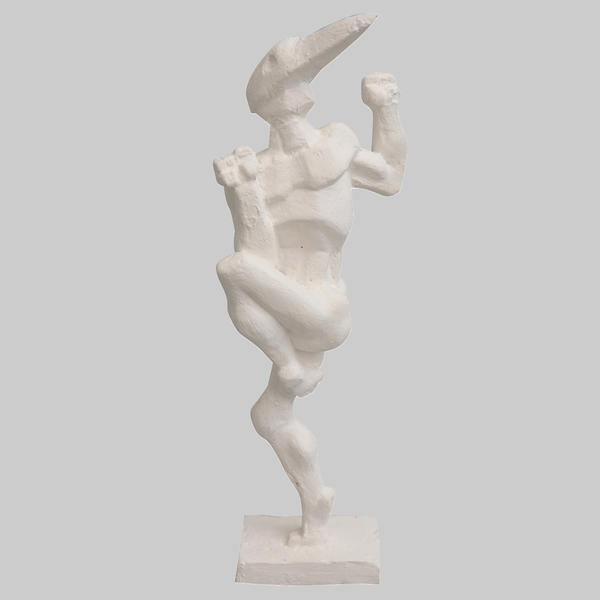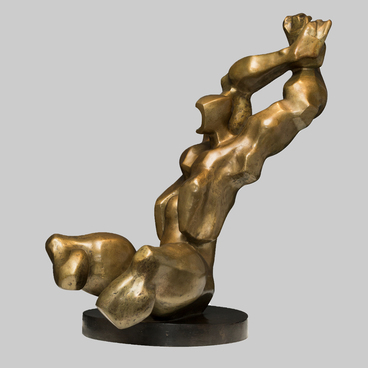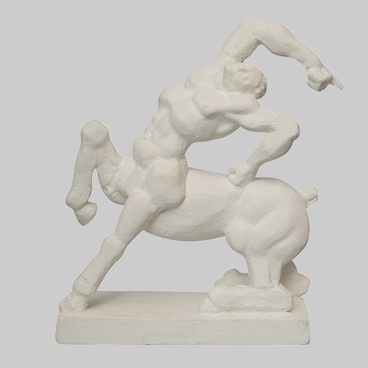Ernst Neizvestny was one of those sculptors who had learned how to create works conveying several meanings at once. This was not just a whim of the master but a particular artistic style, which developed during the postwar years. At the time of the Khrushchev Thaw, he and hundreds of other Soviet artists got the opportunity to express their opinions about various events, including the historical ones. This was how a cycle of sculptures with Yakov Sverdlov emerged, which appeared to be rather decent but on closer inspection turned out to be full of irony, and sometimes even sarcasm.
Ernst Neizvestny remembered that after the war he and his family lived in a world of lies and learned to speak allusively. This concerned both the everyday life and the sphere of creativity and art. The hope that things would change with the coming to power of Nikita Khrushchev was dashed. Moreover, Khrushchev, who in 1962 visited an anniversary exhibition of the Moscow branch of the Union of Artists, ordered to blacklist Ernst Neizvestny. Ironically, after the death of the Head of State, his relatives commissioned the disgraced sculptor to make a tombstone for his grave.
One way or another, Ernst Neizvestny kept this allusiveness in his artistic style until the end of his life. It gave all people the opportunity to see it his works what they wanted to see. For Nikita Khrushchev, the sculptures by Neizvestny were a set of symbols that in no way wanted to come together in a single picture because then he would have had to admit how brave and daring these works were. For this reason, Khrushchev labelled them as degenerative art. At first glance, this degeneracy is clearly visible in the Birdman plaster sculpture: the muscular male figure is crowned with a beaked head, which looks absurd. But what exactly did the artist want to say by this bizarre anatomical symbiosis?
The bird beak instead of the face is just a mask behind which the man is hiding. However, his pose and figure cannot hide the contradictions that tear him apart from the inside. He is standing on one leg, imitating a bird that is about to fly, but the figure shows neither lightness nor anticipation of flight. On the contrary, the tense torso and clenched fists indicate that the man is preparing for a fight. This sculpture is a symbol of a restless artistic personality, which appears to the public as a free bird but knows very well the price of this freedom. After all, at any moment they can be put in a cage and forced to sing there. Knowing this, the Birdman is always alert, ready to tear off his mask and use his fists.
The images of a bird and a mask can be found in many works by Ernst Neizvestny. These two symbols became the master’s favorite metaphors, which helped him make a statement that people were not exactly what they seemed to be, that being constantly under pressure and feeling the need to lie, they evolved, carefully hiding their true selves from those around them.
Ernst Neizvestny remembered that after the war he and his family lived in a world of lies and learned to speak allusively. This concerned both the everyday life and the sphere of creativity and art. The hope that things would change with the coming to power of Nikita Khrushchev was dashed. Moreover, Khrushchev, who in 1962 visited an anniversary exhibition of the Moscow branch of the Union of Artists, ordered to blacklist Ernst Neizvestny. Ironically, after the death of the Head of State, his relatives commissioned the disgraced sculptor to make a tombstone for his grave.
One way or another, Ernst Neizvestny kept this allusiveness in his artistic style until the end of his life. It gave all people the opportunity to see it his works what they wanted to see. For Nikita Khrushchev, the sculptures by Neizvestny were a set of symbols that in no way wanted to come together in a single picture because then he would have had to admit how brave and daring these works were. For this reason, Khrushchev labelled them as degenerative art. At first glance, this degeneracy is clearly visible in the Birdman plaster sculpture: the muscular male figure is crowned with a beaked head, which looks absurd. But what exactly did the artist want to say by this bizarre anatomical symbiosis?
The bird beak instead of the face is just a mask behind which the man is hiding. However, his pose and figure cannot hide the contradictions that tear him apart from the inside. He is standing on one leg, imitating a bird that is about to fly, but the figure shows neither lightness nor anticipation of flight. On the contrary, the tense torso and clenched fists indicate that the man is preparing for a fight. This sculpture is a symbol of a restless artistic personality, which appears to the public as a free bird but knows very well the price of this freedom. After all, at any moment they can be put in a cage and forced to sing there. Knowing this, the Birdman is always alert, ready to tear off his mask and use his fists.
The images of a bird and a mask can be found in many works by Ernst Neizvestny. These two symbols became the master’s favorite metaphors, which helped him make a statement that people were not exactly what they seemed to be, that being constantly under pressure and feeling the need to lie, they evolved, carefully hiding their true selves from those around them.



